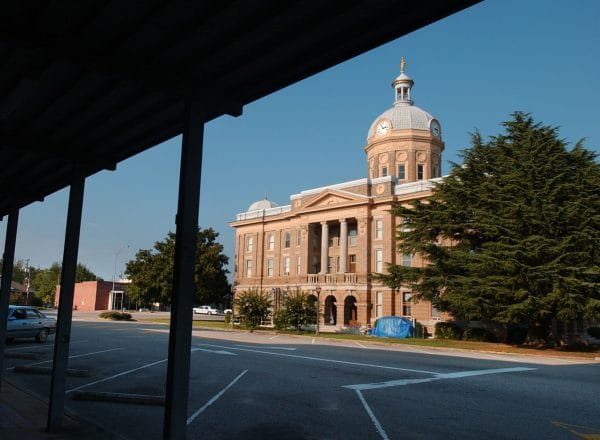Ashland
 Bob Riley, 2003
Ashland is located in east-central Alabama and is the county seat of Clay County. Ashland is named for the plantation home of Kentucky politician Henry Clay, known as “The Great Compromiser.” The town is also known as the “City of Friends.” The town was officially incorporated in 1871; it has a city council form of government with a mayor and five council members who all serve a four-year term. Ashland is the home town of Bob Riley, Alabama’s 52nd governor.
Bob Riley, 2003
Ashland is located in east-central Alabama and is the county seat of Clay County. Ashland is named for the plantation home of Kentucky politician Henry Clay, known as “The Great Compromiser.” The town is also known as the “City of Friends.” The town was officially incorporated in 1871; it has a city council form of government with a mayor and five council members who all serve a four-year term. Ashland is the home town of Bob Riley, Alabama’s 52nd governor.
History
Clay County was formed on December 7, 1866, and less than a year later, Ashland was established as the county seat. In 1867, the first courthouse, a wood structure, was erected, but on December 18, 1875, the courthouse burned and all records were destroyed. On May 6, 1878, a second brick courthouse was constructed.
 Hugo Black in Ashland
Ashland played an important role in education in Clay County. In the 1920s, most schools in Clay County were one-room schoolhouses, serving grades 1-9. After graduating ninth grade, students who continued their education were bused to either Ashland or Lineville to complete high school.
Hugo Black in Ashland
Ashland played an important role in education in Clay County. In the 1920s, most schools in Clay County were one-room schoolhouses, serving grades 1-9. After graduating ninth grade, students who continued their education were bused to either Ashland or Lineville to complete high school.
Another important part of Ashland’s history is the Clay Times-Journal, which began as the Lineville Headlight in 1902 and has remained in the same building ever since. By the mid-to-late 1930s, the name changed to the Lineville Tribune. In 1947, Lester Proctor bought the paper and then bought the Ashland Progress in 1955. In 1990, he combined the two, establishing the Clay Times-Journal, making it the oldest newspaper in Clay County. The paper is sold each Wednesday throughout the United States and even as far as Canada.
Economic Development
During Ashland’s earliest years, the town grew so quickly that many commentators predicted it would become more prosperous than Birmingham. In 1899, Alabama’s first graphite mine, Allen Graphite, opened in Clay County at a time when graphite was being used for a variety of applications. As a result, Ashland and all of Clay County prospered. Graphite was used extensively during World War I as a lubricant and liner for foundry molds. When the war ended, the market for graphite dropped and at the same was overrun by cheaper foreign graphite imports, thus ending Ashland’s industry.
As the graphite industry wound down, Ashland began to prosper in other ways. National prohibition of alcohol sales helped the local economy by boosting sales of sugar, rye, and other raw materials used for making illegal liquor. However, sales of moonshine dropped drastically with the repeal of Prohibition in 1933. Clay County had remained dry though, and had been the state’s last dry county, until March 2016, when Ashland and the city of Lineville approved the sale of alcohol.
 Ashland Town Square
The early twentieth century brought both the boll weevil and the Great Depression to Ashland. The weevil destroyed the cotton industry in the area, forcing many cotton farmers to abandon farming and to work for the Work Projects Administration (WPA). The cotton industry was later replaced by cattle and hay farming, and today many citizens of Ashland, including former Alabama governor Bob Riley, continue to operate cattle farms.
Ashland Town Square
The early twentieth century brought both the boll weevil and the Great Depression to Ashland. The weevil destroyed the cotton industry in the area, forcing many cotton farmers to abandon farming and to work for the Work Projects Administration (WPA). The cotton industry was later replaced by cattle and hay farming, and today many citizens of Ashland, including former Alabama governor Bob Riley, continue to operate cattle farms.
Railroads initially were important to the economic development in Ashland and the rest of Clay County. At one time, three major railroads, the Eastern Railway of Alabama, the Alabama Northern Railroad, and the Central of Georgia Railroad, served the area. These lines served local residents, farms, businesses, and lumber mills, and they also played an important role in supporting the graphite mines. The Alabama Northern Railroad was built by local citizens in 1905 to provide extended service to Ashland. It had its last run in the late 1920s. By 1939, the tracks themselves were removed and sold for scrap and, in 1940, the first major highway was completed, running to the state capitol of Montgomery.
Demographics
Ashland’s population according to the 2020 Census estimates was 1,680. Of that number, 72.0 percent of respondents identified themselves as white, 27.0 percent as African American, 0.6 as Asian, 0.4 percent as Hispanic or Latino, and 0.4 percent as two or more races. The town’s median household income was $25,793, and the per capita income was $16,893.
Employment
According to 2020 Census estimates, the workforce in Ashland was divided among the following industrial categories:
- Manufacturing (31.7 percent)
- Educational services, and health care and social assistance (23.4 percent)
- Retail trade (14.7 percent)
- Other services, except public administration (9.4 percent)
- Professional, scientific, management, and administrative and waste management services (5.9 percent)
- Arts, entertainment, recreation, and accommodation and food services (4.2 percent)
- Construction (4.2 percent)
- Information (2.0 percent)
- Wholesale trade (2.0 percent)
- Finance, insurance, and real estate, rental, and leasing (1.1 percent)
- Public administration (0.9 percent)
- Transportation and warehousing and utilities (0.5 percent)
Education
Schools in Ashland are part of the Clay County school district; the town has one public elementary school and one public high school as well as one private K-12 school.
Transportation
Ashland is served by two major highways. Alabama Highway 9, Ashland Street, runs northeast-southwest through Ashland. Alabama Highway 77 serves as an artery, running northwest-southeast through Ashland.
The city of Ashland also maintains the Ashland/Lineville Airport, a county-owned airport intended for public use. During the 12-month period ending in February 2007, the 35-acre airport recorded 2,863 general aviation aircraft operations.
Events and Places of Interest
 Ashland Skateboard Park
Ashland has several recreational parks and nature trails. City Park offers a skateboard course, a variety of children’s recreational equipment, tennis courts, an amphitheater, and a lighted walking trail.
Ashland Skateboard Park
Ashland has several recreational parks and nature trails. City Park offers a skateboard course, a variety of children’s recreational equipment, tennis courts, an amphitheater, and a lighted walking trail.
The Clay County Arts League, working with Ashland Theatre, provides productions and art exhibits for the community. One annual exhibit, “Through the Artist’s Eyes,” promotes local artists and is held at the Clay County Wellness Center. The Historic Ashland Theatre has been newly renovated and provides events for the Ashland community. The building was originally built in 1914 and operated as a bank, but after the building was expanded, it opened as the New Ashland Theatre in 1943.
The Clay County Courthouse, which was built in 1906 and is an example of Italian Renaissance architecture, is listed on the National Register of Historic Places, as is the Hugo Black House.
Additional Resources
Heritage of Clay County, Alabama. Clanton, Ala.: Heritage Publishing Consultants, Inc., 1998.



